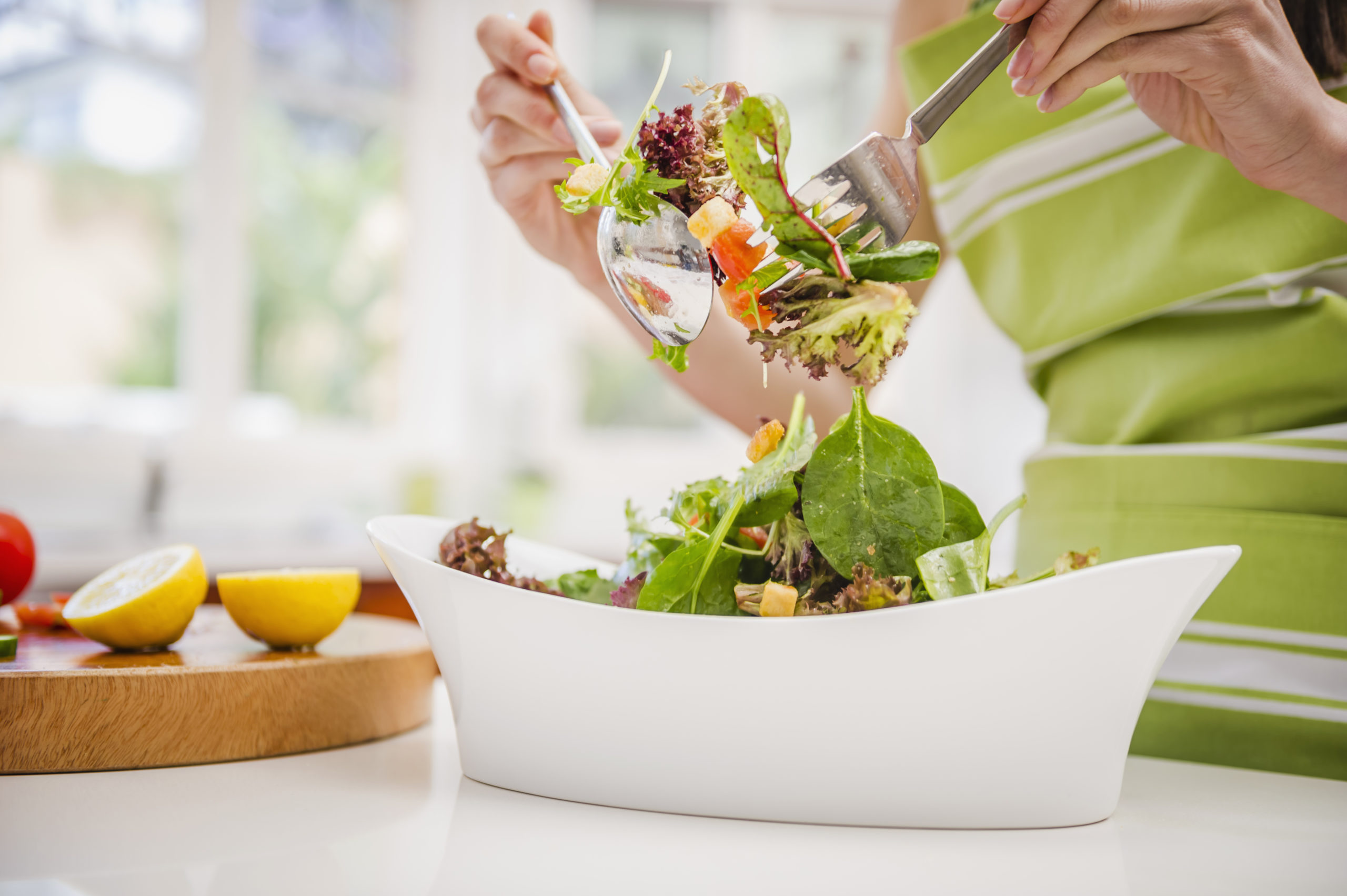
Nutritionist Katie Lemons explains why a personalized diet may be easier to stick to—and better for you to boot.
.

Based in Boston, Katie Lemons is a nutritionist who is fascinated by the impact nutrition can have on chronic diseases. In a guest blog post, Katie gives us ten nutrition guidelines for better health, explains why mindful eating is so important, and reveals why eating chocolate isn’t a no-no.
10 Ways to Add Health to Your Meals
By Katie Lemons
One of my absolute favorite things about nutrition is how personalized it is. Diversity and variety are the spices of life, after all, along with rosemary and thyme. This diversity is represented in the many different ways people eat to feel good. Because at the end of the day, it’s all about feeling your best. The ultimate goal is to fuel and nourish your mind and body in a way that optimizes energy and vitality, in turn enabling you to function at your highest mental and physical capacity.
What I most love about nutrition, however, can sometimes lead to some serious frustration. It would certainly be a lot easier if there was a one-size-fits-all approach—one single diet that would work perfectly for everyone. But where’s the fun in that? While there are many variations to each individual’s diet, in times of frustration or diet ambiguity, there are some general tenets I abide by for optimal health and performance.
Rather than thinking about “diet” as a language of elimination and removal, it’s much more liberating and realistic to instead think about which foods and food groups to add in. It’s also helpful to not only think about what you’re eating, but how you’re eating. By adopting slow and mindful eating habits, each meal presents an opportunity to nourish, satiate, and comfort.
1. Eat mostly whole plants
You can never go wrong with a heaping pile of plants on your plate. Bursting with antioxidants and phytonutrients, a diet consisting mostly of plants plays a key role in a healthy immune system, gut, energy levels, mood, and even skin. During the winter months when flu, coughs, and colds are lurking around every corner, a great way to hug the immune system is a healthy dose of vitamins and minerals from fruits and vegetables every day. Hint: if a vegetarian or vegan diet is right for you, pair that non-heme, plant-based iron, such as spinach, lentils, chickpeas, or beans, with a source of vitamin C for increased absorption. Just a little squeeze of lemon or lime juice can go a long way.
2. Eat healthy fats, including nuts, seeds, and omega-3 fatty acids
Fats are essential for energy and supporting cell growth, as well as helping to absorb certain nutrients. They’re essential to all diets, and help increase satiation from meals, meaning we feel fuller, longer. A diet high in healthy fats can also help to combat inflammation. Reach for avocados, chia seeds, hemp seeds, nuts, seeds, and nut butters on the regular.
3. Choose regeneratively and responsibly raised animal products and seafood when possible
While what is on my plate is of course important, I also like to be mindful of how it got there. While I don’t eat a ton of meat, when I do, I invest in food from producers who are committed to responsibly and humanely raising animals, as well as regenerative farming for food supply now and for years to come. It’s also a way to ensure I’m eating high-quality animal sources without added antibiotics and hormones.
4. Improve gut health with increased fiber intake, such as beans and whole grains, probiotic foods, and even chocolate
I like to think of each meal as a means to improve my gut health. Interestingly, the gut produces 75% of neurotransmitters in the body (happy brain chemicals!) and contains two-thirds of the body’s immune system. One way of doing so is increasing fiber intake, particularly prebiotic fiber to feed the good gut bacteria. I aim for 30-40g a day from foods like artichokes, quinoa, brown rice, asparagus, chickpeas, hummus, kidney beans, and sweet potatoes, most of which are great veggie sources of protein too. I also strive to eat a forkful of fermented foods a day, like kimchi and sauerkraut. These are great sources of probiotics and have millions of beneficial bacteria, which can have therapeutic effects when consumed regularly.
I also like to use a lot of cacao powder—in smoothies, cookies, hot chocolate, whatever. High-flavanol cocoa drinks result in increases in fecal bifidobacteria and lactobacilli (good bacteria) and reduced clostridial counts (bad bacteria), plasma triglycerides (unhealthy fats), and C-reactive proteins (inflammatory markers).
5. Flavor dishes naturally with fresh and dried herbs and spices
Not only does this greatly add to the flavor punch of each dish, but it also serves to enhance the polyphenol content. This is a fancy word for nutrients that have both antioxidant and anti-inflammatory properties. I love sprinkling rosemary and turmeric on my morning eggs or some dill on a chickpea “tuna” mash.
6. Stay conscious of sugar intake
While it’s not at all realistic to avoid sugar completely, it’s a useful tactic to stay mindful of just how much you’re consuming and to check labels for those sneaky sugar sources. When possible, reach for more natural sugar sources with fiber, such as dates, honey, maple syrup, and coconut sugar, to help slow absorption and avoid major blood sugar spikes.
7. Be aware of refined carbohydrates and vegetable oil consumption
Similar to sugar, refined carbohydrates can lead to uneven blood sugar spikes because they’re stripped of all of their bran, fiber, and nutrients. Refined sugars and vegetable oils are major ingredients in a lot of processed foods. The oils must undergo intensive mechanical and chemical processes for extraction, and are high in omega-6 fatty acids, making them quite inflammatory. Instead, stick to poly/monounsaturated fats (nuts, seeds, avocado) and omega-3 fats (wild-caught salmon) for a more balanced omega-6 to omega-3 ratio. Some studies report it should be close to 1 for optimal inflammation suppression.
8. Stay hydrated
Drinking enough water throughout the day is important for just about all the body’s internal processes—regulating body temperature, keeping organs functioning well, and even improving sleep quality, focus, and mood. It’s also essential after a workout to replace what was lost through sweating. Hydration can come right from water itself, or from certain fruits and vegetables with high water content, such as celery, watermelon, cantaloupe, strawberries, and cucumbers, to name a few.
9. Practice mindfulness and gratitude with each meal
Embedding mindfulness and gratitude into each and every meal not only aids satiation and enjoyment, but also helps with digestion. By taking things slowly and savoring each bite, we remind the body to be in its relaxed parasympathetic mode—commonly referred to as the “rest and digest” state—rather than the high-alert, stressed-out sympathetic state, aka “fight or flight.” It helps to improve both the physical and psychological relationship with food.
10. Try to use leftovers to prevent food waste
It’s easy to get caught up at the grocery store, especially when you’re shopping while hungry, so meal planning beforehand is a necessity for me. This way, I can carefully craft a menu and use up any/all leftovers to avoid food waste. It also doesn’t hurt that money is saved in the process.
Thanks, Katie! To catch up with Katie, check out her website Twist of Lemons.



